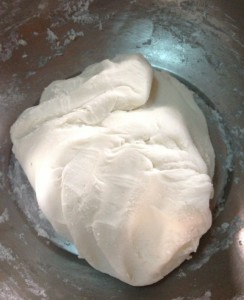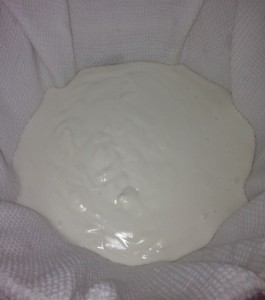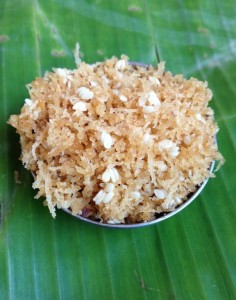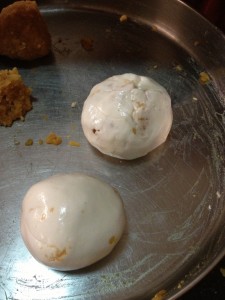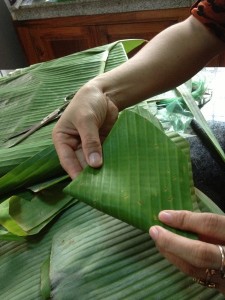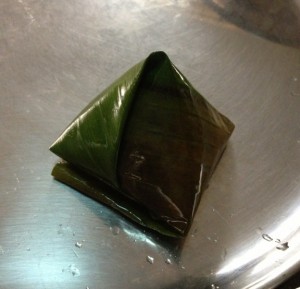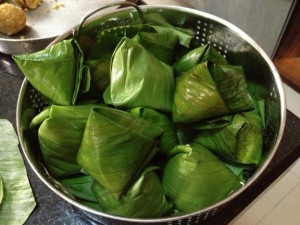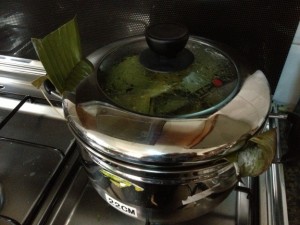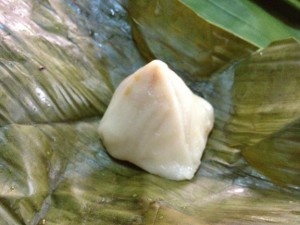By Dosaikal
Num Kom is one of the speciality sweets of Cambodia. It is very similar the ‘Kozhukkattai’ made in Tamilnadu, the state where I come from in the South of India. Rice being our staple food too, different kinds of main course, snack and desserts are made of Rice. We do not have the authentic Khmer sticky rice. But there are different varieties of Rice – one for making Idlies (dosaikal.com/idli-steamed-rice-cakes) and Dosais (dosaikal.com/basic-dosai) and other for making rice. Many more choices to make desserts, rice powders, idiyappam or the rice noodles or Puttu – the funnel cake.
An interesting fact about Num Kom is the filling inside and the rice flour outside is almost the same as the filling stuffed inside ‘kozhukkattai’ or ‘modhakam’, (dosaikal.com/modhakam-pillayar-chaturthi-special) a festive steamed sweet of India. We also have ‘Ellu Kozhukkattai’- or the Non-sticky Rice Num Koms stuffed with sesame seeds and jaggery. Please refer sweets and desserts of my blog – www.dosaikal.com for jaggery – or ‘schou umpeu’ based sweets (dosaikal.com/jaggery-based-sweets). There are also other variants in rice flour based steamed dumplings like Inippu Kozhukkattai (dosaikal.com/inippuvella-k-kozhukkattai-jaggery-rice-dumplings) or spicy salted Kozhukkattai(dosaikal.com/pidi-kozhukkattai-salted-rice-dumplings/).
Cambodia with the staple food rice has many varieties of food made with Rice, especially the Glutinous Rice or the Sticky Rice.
Glutinous rice (Oryza sativa var. glutinosa; also called sticky rice, sweet rice or waxy rice) is a type of rice grown mainly in Southeast and East Asia, which has opaque grains, very low amylose content, and is especially sticky when cooked. It is called glutinous (< Latin glūtinōsus)[1] in the sense of being glue-like or sticky, and not in the sense of containing gluten. While often called “sticky rice”, it differs from non-glutinous strains of japonica rice which also become sticky to some degree when cooked. http://en.wikipedia.org/wiki/Sticky_rice
Some of the main delicacies made for special occasions with the Sticky Rice are the different kinds of Rice Cakes. Special occasions can be Weddings, Khmer New Year or Pchum Ben (Festival devoted to worship of ancestors).
The Rice Cake varieties can be Num Kom, Num Ansom Chrouk and Nom Ansom Chek. Num means Cake in general. Nom Kom is the Rice Cake with coconut and palm sugar filling. Ansom Chrouk has a filling mainly of pork fat and green bean and can be a main course. Ansom Chek has a filling of banana and it is served as a dessert.
During Pchum Ben – where the ancestors of every family are worshipped – women of the household, young and old sit together and prepare Num Kom. The Rice Cakes require a lot of time wrapping them in banana leaf – folded in a particular pattern. While Num Kom – the coconut filled rice cake needs less time comparitively, there are other fillings to the rice cake – like pork meat – cooking time of which is longer. So, they say the womenfolk sit chatting in the night making hundreds of rice cakes, while the different kinds of cakes get cooked for the next day ceremony.
Thanks to http://blog.aseankorea.org/archives/16079 – from which I could collect some interesting information about these Rice Cakes.
Special thanks to my friend and one of the pioneer bloggers of Cambodia at a very young age – Keonila of blueladyblog.com for helping me out in the search of more authentic information. Also patiently answering my doubts on the fillings of Num Kom. Thankyou Nila!
And all those other friends who may be reading this – do correct me when I am wrong on information – and please do not hesitate to share your thoughts. This would help me get a better insight into the traditions and culture behind the cuisine of Cambodia!
This Rice Cake could not have been prepared without the guidance and helping hands of friend ‘D’, who played teacher in letting me learn this cake – with the taste and twist (literally) of banana leaves. Thank you ‘D’.
Num Kom
Num Kom is a Rice Cake made with the outer shell of Sticky Rice with a filling of coconut and palm sugar, wrapped in banana leaf and steamed.
Originally palm sugar is used as sweetener. Since I did not have it, I substituted with the home made jaggery syrup which was available.
Ingredients (makes 7-8 num koms)
for the filling
- glutinous rice/sticky rice – 175 grams (1 cup – a little more or less)
- grated coconut – 1 cup
- sesame seeds – 3 tsp
- jaggery syrup – little less than 1/2 cup
- salt – a pinch
- banana leaves to wrap
Method of Preparation
I. Preparation of Outer Shell/Rice Covering
We decided to go for the traditional method of soaking rice and making a paste. The paste is strained in a netted cloth and the water content remaining in the paste would go. Then, hot water is added to somewhat dry dough to make it easy to wrap the filling inside.
This was a flop with the cloth I had was thick and could not strain the water away.. Emergency!!! Got some glutinous rice powder and mixed it with the rice paste and converted it into the required right consistency to make Num Kom.
Keep aside.
II. Preparation of filling
- In a wide pan, dry roast sesame seeds till slightly brown. Preferably black sesame – but I had white.
- Switch off the stove and add grated coconut and jaggery syrup
- If one uses palm sugar, it mixes well very fast and easily
- Frying more or making the filling thick and sticky as in south indian dumplings is not needed here
- Mix well and keep aside.
- Make small balls of rice dough
- Flatten each to keep the filling inside
- Fill with coconut-sesame-jaggery filling
- Close and make a ball
IV. Folding the Rice Cake in Banana Leaf
1. Cut the banana leaves in 8 by 7 inches
2. Wash the leaves well and wipe them clean with cloth
3. Fold each leaf vertically and give it a slightly cross cut
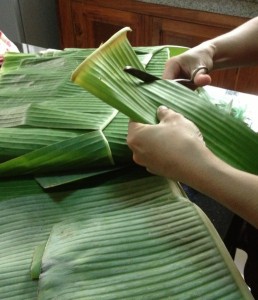
4. The cut leaves look like this

5. Fold it vertically – one fold
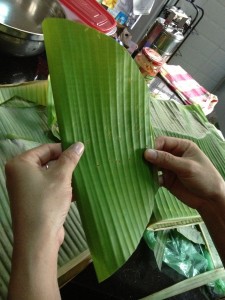
7. There would be two pockets – open the wider pocket
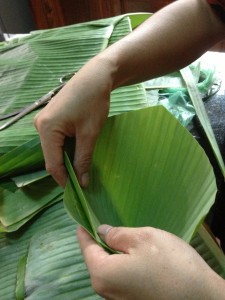
8. Grease the leaf and place the Rice Cake inside
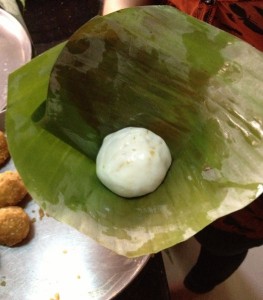
9. Do not close it the same side where the leaf looks ‘V’ – but, fold the leaf to close the cake in the middle portion where there is a double slit – now, this is a tricky part I forgot to capture. I was learning to close it and was quite successful too. But no photos please. Shall try again for sure!
10. Done and the cakes are ready to be steamed.
- Boil water in a steamer
- In the container, place banana leaves as base. This prevents the num koms from sticking to the bottom of the vessel and also gives more banana leaf fragrance and flavour to the steamed cakes
- Arrange the prepared rice cakes. Be careful not to damage the shape
- Place more banana leaves on top and close the steamer with lid
- Steam for about 15 minutes
- Num Kom is ready.
Sounds so similar, feels so familiar – yet so different! This holds good to the cuisine connections of Cambodia and South India! Shall explore more…
I am ‘Dosaikal’ a food blogger (www.dosaikal.com) who believes in strong traditional values and transfer of traditions to the next generation. I am always fascinated by different kinds of food from different parts of the world. I am especially impressed with the strong connection that south of india has with cambodia, in terms of food and temple architecture.





